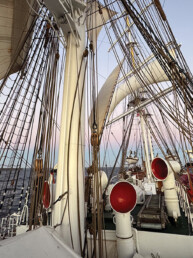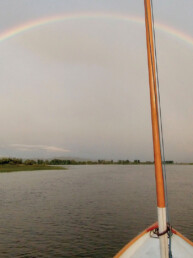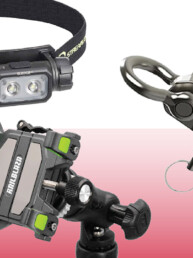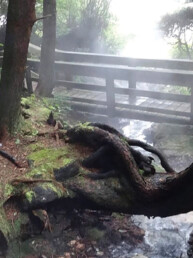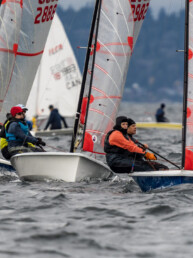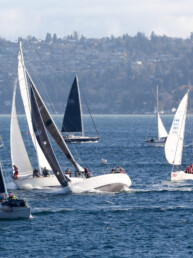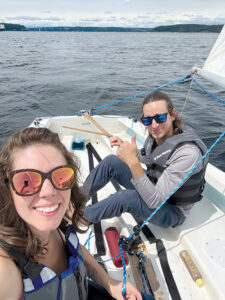
I recently reached the five-year anniversary of living aboard my Hunter 43 Legend, Muse, and what a great life decision it has been. I truly love my tiny floating home, but as most marina tenants will tell you, the actual time spent boating is less than you might imagine. Living on Muse is the easy part. It’s getting off the dock that’s hard.
Turning our cozy family residence into a functioning sailboat is a lot of work, with a long list of things to stow, unplug, and secure. With a 65-foot mast, we also require drawbridge clearance, which has to be arranged with the city’s bridge operators at least two hours in advance when we’re on our way out, as well as back in.
So you can probably understand my policy that if Muse is getting into cruising mode, “We are going somewhere, dangit!” This is why, aside from my prepurchase sea trial back in 2018, I’ve never been out for a daysail on this boat. When we go out, it’s for two nights minimum.
This has been working pretty well for us the last few years, but this season is different. We are consumed nearly every weekend with a new project: building a retreat center on Harstine Island. Sure, we could sail there and drop anchor in Jarrell Cove or at McMicken Marine State Park. But it’s just so easy to drive the 20 miles from Tacoma and use what would have been a 12-hour round trip sail for more time spent laboring away as we build our new vision.
So Muse sits at the dock, faithfully tied up for the season. And, although lovely, the only slice of water we enjoy is right in downtown Tacoma with constant car, train, and factory noises. With this ever-present cacophony, it’s easy to forget what splendor lies just outside the Foss Waterway. I didn’t realize how much I had missed it until my husband, Andrew, found a way for us to venture out for short sails without all the fuss of getting Muse out of her slip and through the bridge.
Being a fair-weather weekend cruiser who sees sailing as a means to an end and not necessarily as an objective in itself, I could come to terms with this weird non-boating boating season. Andrew could not.
He’s the type who can’t go more than five minutes without trimming sails, even on a long leg of a laid-back cruise; is always spotting other boats to race, whether they’re aware they’ve entered into a competition or not; and has trouble relaxing at anchor if there’s a perfect breeze blowing. It’s a feeling like he’s missing out on a golden opportunity to be out sailing once again.
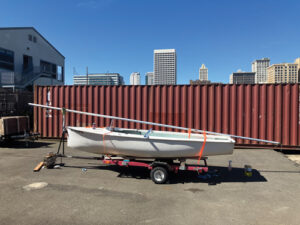
A year without sailing was unacceptable to him, so he took action back in April and bought us a 1960s C-Lark 14, a little daysailer sloop with a centerboard. After months of research, he knew this was the boat he wanted, and he had been scoping out his options on Craigslist for a while. Every time he got close to making the purchase, however, he felt guilty. Should he really spend $800 on something recreational when we have so many other important things to invest in right now? In the end, he decided that his happiness and quality of life were worth the expense, and I completely agreed. Apparently the powers that be did, too, because a few days later he received a check in the mail from a class action lawsuit for just over $800.
Eager to get on the water, Andrew quickly made a few repairs and upgrades, including swapping out crusty old lines and cable halyards for brand new Sta-Set running rigging, installing new Harken blocks and cleats, affixing a new windex to the top of the mast, incorporating hiking straps to secure feet when the boat is heeled, and adding a float to the top of the mast to prevent the boat from turtling in the event of a full 180° capsize.
He also made some necessary fiberglass repairs, re-cored the transom with Divinycell, and scooped out all the old styrofoam inside the seats. The foam had originally provided enough buoyancy to prevent the boat from sinking, but it wasn’t doing much good in its heavily degraded state. Rather than replace it with new foam, he chose to use airbags made for Opti sailboats, which are nearly perfect in size. New black antifouling paint and shiny teal topside paint provided the finishing touches, and by late May she was ready to splash.
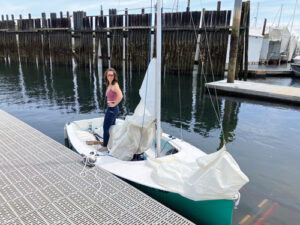
His childlike enthusiasm was infectious. I couldn’t help but be excited and happy about this new addition, even if I did imagine capsizing in the chilly waters of Commencement Bay with every gust of wind or minor error in weight adjustment.
I was grateful Mother Nature took it easy on me that first day as we launched the C-Lark at Point Defiance and ghosted our way back downtown. Aside from a few small puffs, it was very slow going—so uneventful, in fact, that we started up the slightly eerie, mysterious island-vibe playlist that we usually reserve for becalmed cruising days. It instantly zaps the frustration and makes windless moments fun and memorable. A stretch of water that would normally take us an hour to cover took three hours that day, and we had a blast.
We got the C-Lark tied up next to Muse, ready to go on mini-adventures at a moment’s notice. Andrew was like a kid at Disneyland, but I was still worried about the wind absolutely flattening us in that tiny little bathtub of a boat, especially without a heavy keel to keep us upright. Seemingly aware of my thoughts, Andrew promised to only ever take it out in safe conditions. He’s had a lot of experience in small boats racing on Lake Pleasant near Phoenix, and our doublehanding has gotten better over the years. I knew we were both sea-smart and capable sailors, so I made a conscious choice not to let my fear stop me, and I made an internal commitment to always say yes when Andrew suggested we go out for a sail… which is a lot.
It really didn’t take long before my anxiety was replaced with thrill and delight at being so close to the wind and water, flying out toward the bay. The breeze builds, and I intuitively lean back, brace my feet, and raise myself up to sit on the rail and compensate for the power of the wind with the weight of my body. If it’s still too much, we ease the sheets.
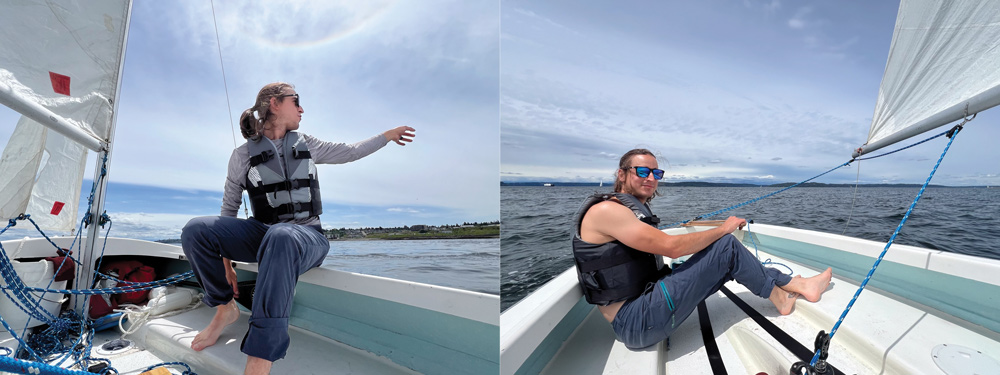
The C-Lark is surprisingly steady for having a centerboard. She wants to sail—to be in her happy place—and she seems to naturally stiffen up as the rail gets close to the water. That’s when the real magic happens. We become like one organism: the boat, Andrew, and me. Each reading one another’s energy, and sometimes even communicating without words. I know that we’re simply processing data—the wind, sail trim, the degree of heel, the waves—and responding, but it feels like so much more than that.
We aren’t the only Foss Harbor liveaboards who feel this way. There are three other C-Larks in the marina with a potential fourth in the works. It won’t be long before the neighborhood fleet is organizing races, and Andrew couldn’t be more excited to get back to the sport he loves.
Sometimes I still feel a bit guilty about not getting Muse out of her slip more often, but she’s very well cared for, being owned by a professional marine repair person. And right now she’s providing the coziest, most interesting city dwelling I could ever have imagined. We love our home so very much, and I believe she loves us back. The time for cruising will come again, and I’ll be a better sailor when it does.
In the meantime, the C-Lark has made a profound and surprising improvement to our lives on the water. And I’m happy to report that we haven’t had a single capsize.
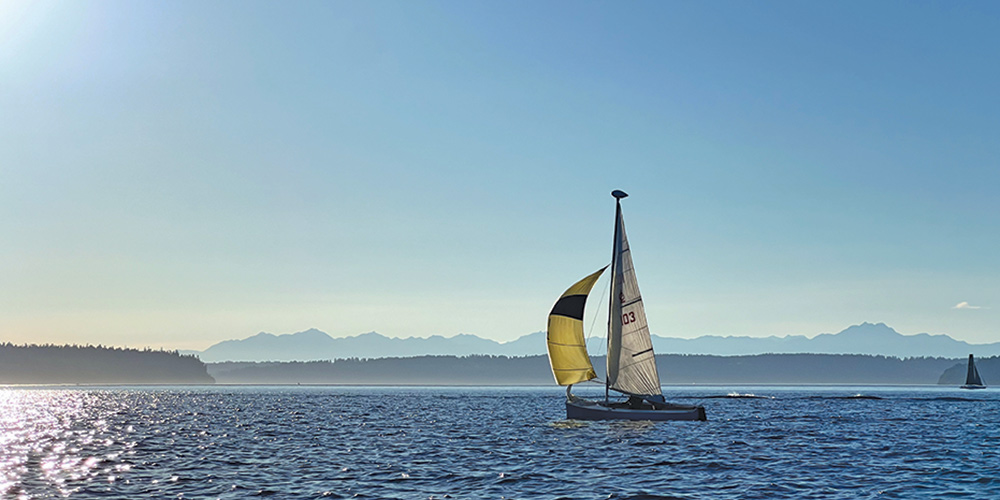
Samantha McLenachen and her husband, Andrew, live aboard with their children in Tacoma, Washington. They proudly own the small, local marine repair business Independent Marine Service.
Samantha McLenachen
Samantha McLenachen and her husband, Andrew, live aboard with their children in Tacoma, Washington. They proudly own the newly opened marine repair business, Independent Marine Service.

